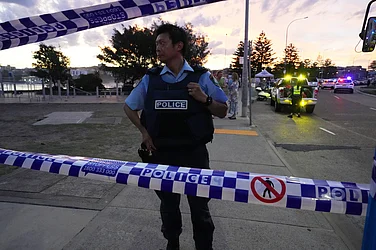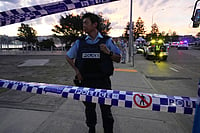Hospitals in China continue to be overwhelmed amid an unprecedented surge in Covid-19 infections.
In China's capital Beijing, patients are lying on stretchers in hallways and getting treatment in wheelchairs as hospitals have run out of rooms and beds. Most of these patients are elderly, most vulnerable to Covid-19.
Visuals have also surfaced from China's financial hub Shanghai showing patients being treated outside the emergency department of a hospital on the road as there is no space inside the hospital.
In recent weeks, reports have said that Chinese authorities are covering up the true extent of Covid-19 outbreak in the country.
In Beijing, the Chuiyangliu hospital was packed with newly arrived patients on Thursday. By mid-morning, beds had run out even as ambulances continued to bring those in need. Hard-pressed nurses and doctors rushed to take information and triage the most urgent cases.
In recent weeks, emergency wards in the towns and cities to Beijing's southwest are overwhelmed and intensive care units (ICUs) are turning away ambulances and residents are forced to driving sick relatives from hospital to hospital.
The surge in severely ill people needing hospital care follows China abandonment of its most severe pandemic restrictions last month after nearly three years of lockdowns, travels bans and school closures that weighed heavily on the economy and prompted street protests not seen since the late 1980s.
Covid testing for Chinese travellers
It also comes as the the European Union on Wednesday “strongly encouraged” its member states to impose pre-departure COVID-19 testing of passengers from China.
Over the past week, EU nations have reacted with a variety of restrictions toward travelers from China, disregarding an earlier commitment to act in unity.
Italy —where the pandemic first exacted a heavy toll in Europe in early 2020— was the first EU member to require coronavirus tests for airline passengers coming from China, but France and Spain quickly followed with their own measures.
That followed the imposition by the United States of a requirement that all passengers from China show a negative test result obtained in the previous 48 hours before departure.
China has warned of “countermeasures” if such policies were to be imposed across the bloc.
WHO concerned with lack of data from China
World Health Organisation (WHO) head Tedros Adhanom Ghebreyesus said Wednesday he was concerned about the lack of outbreak data from the Chinese government.
At a daily briefing on Thursday, Chinese Foreign Ministry spokesperson Mao Ning said Beijing has consistently “shared information and data with the international community in an open and transparent manner".
Mao said, “At present, China's COVID-19 situation is under control. Also, we hope that the WHO secretariat will take a science-based, objective and impartial position to play a positive role in addressing the pandemic globally."
The terse language between China and the WHO contrasts sharply with what critics in the US Congress and elsewhere called an overly friendly relationship between the two as the UN organisation sought to probe the origins of the pandemic.
While the first cases were reported in the central Chinese city of Wuhan in late 2019, China has claimed the virus originated in the US or Europe and has been accused of withholding data that could help narrow the search for the cause.
Get vaccinated, don't travel: Chinese authorities
In dealing with the latest outbreak, China has sought to get more of its elderly population vaccinated, but those efforts have been hampered by past scandals involving fake medications and previous warnings about adverse reactions to the vaccines among older people.
China's domestically developed vaccines are also considered less effective than the mRNA jabs used elsewhere.
Meanwhile, local authorities in some areas are appealing to the public to avoid traveling during this month's Lunar New Year holiday, as the last formal restrictions on movement are lifted.
“We recommend that everyone not return to their hometowns unless necessary during the peak of the outbreak,” the government of Shaoyang county in Hunan province in central China said in a notice dated Thursday. “Avoid visiting relatives and traveling between regions. Minimize travel.”
Similar appeals were issued by Shouxian county in Anhui province southeast of Beijing and the cities of Qingyang in Gansu province in the northwest and Weifang in Shandong on the east coast.
The Weifang government notice said residents should celebrate the holiday with video and phone gatherings.
“Avoid visiting relatives and friends to protect yourself and others,” it said.
Despite such concerns, Hong Kong announced it will reopen its border with mainland China on Sunday and allow tens of thousands of people to cross from each side every day without being quarantined.
It was unclear what restrictions people travelling to the mainland side would face.
The city's land and sea border checkpoints with the mainland have been largely closed for almost three years and the reopening is expected to provide a much-needed boost to Hong Kong's tourism and retail sectors.
What's driving Covid-19 surge?
The China's Covid-19 surge is being driven by BF.7 Omicron sub-variant. It's full name is full name is BA.5.2.1.7.
The strain is highly transmissible and has immunity-evading abilities.
the reproduction number (R0) of the BF.7 Omicron sub-variant is 10 whereas it was 5-6 for Delta variant.
R0 is a number that measures how transmissible an infectious disease is. The higher the number, the more infectious it is.
"R0 tells you the average number of people who will contract a contagious disease from one person with that disease...For example, if a disease has an R0 of 18, a person who has the disease will transmit it to an average of 18 other people," says Healthline.
The Global Times reported that the 10 R0 of BF.7 is the lower limit. It can cross 18 in some cases.
The mutations give BF.7 some immune-evasive abilities, which means it can escape immunity from vaccine or previous infection, according to microbiology expert Manal Mohammed of University of Westminster.
"A recent study examined the neutralisation of BF.7 in sera (a component of blood that should contain antibodies) from triple-vaccinated healthcare workers, as well as patients infected during the omicron BA.1 and BA.5 waves of the pandemic. BF.7 was resistant to neutralisation, driven partly by the R346T mutation," notes Mohammed in an article for The Conversation.
Up to 2 million deaths projected in China
Projections have said that betweem 1.3-2.1 million people can die in China in the ongoing Covid-19 surge.
The Economist reports around 1.5 million Chinese could die based on its model that calculates the trajectory of China's outbreak under different scenarios based on estimates of the rates at which people become infected, get sick, recover or die – referred to as the SEIR model, according to PTI.
It reports The Lancet’s report quoting a projection saying that somewhere between 1.3 and 2.1 million people could die from Covid-19 after China re-opens.
Chinese authorities covering up?
There are also reports saying that the Chinese authorities are covering the true extent of the Covid-19 outbreak.
Last month, Reuters reported that dozens of funeral took place in Beijing with funeral staff in hazmat suits despite China reporting zero Covid-19 deaths.
"At a crematorium in Beijing's Tongzhou district, a Reuters witness saw a queue of about 40 hearses waiting to enter while the parking lot was full. Inside, family and friends, many wearing traditional white clothing and headbands of mourning, gathered around about 20 coffins awaiting cremation. Staff wore hazmat suits and smoke rose from five of the 15 furnaces," reported Reuters.
It also reported that medicines are in shortage at places in China.
"The abrupt change of policy has caught a fragile health system unprepared and hospitals are scrambling for beds and blood, pharmacies for drugs, and authorities are racing to build special clinics," reported Reuters.
(With AP inputs)


























